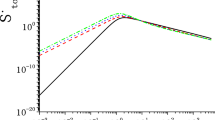Abstract
Jacob Bekenstein's identification of black hole event horizon area with entropy proved to be a landmark in theoretical physics. In this paper we trace the subsequent development of the resulting generalized second law of thermodynamics (GSL), especially its extension to incorporate cosmological event horizons. In spite of the fact that cosmological horizons do not generally have well-defined thermal properties, we find that the GSL is satisfied for a wide range of models. We explore in particular the case of an asymptotically de Sitter universe filled with a gas of small black holes as a means of casting light on the relative entropic ‘worth’ of black hole versus cosmological horizon area. We present some numerical solutions of the generalized total entropy as a function of time for certain cosmological models, in all cases confirming the validity of the GSL.
Similar content being viewed by others
REFERENCES
J. D. Bekenstein, Phys. Rev. D 7, 2333 (1973).
S. W. Hawking, Phys. Rev. Lett 26, 1344 (1971).
S. W. Hawking, Commun. Math. Phys. 43, 199 (1975).
S. W. Hawking, Phys. Rev. D 13(2), 191–197 (1976).
P. C. W. Davies, S. A. Fulling, and W. G. Unruh, Phys. Rev. D 13(10), 2720–2733 (1976).
G. W. Gibbons and S. W. Hawking, Phys. Rev. D 15, 10 (1977).
C. H. Lineweaver, “Cosmological parametersz,” in Proceedings COSMO-01, Rovaniemi, Finland, preprint astro-ph/0112381 (2001).
J. L. Sievers et al., “Cosmological parameters from cosmic background imager observations and comparisons with Boomerang, DASI and MAXIMAz,” submitted to Astrophys. J., preprint astro-ph/0205387 (2002).
T. Kiang, Chinese Astronomy and Astrophysics 21(1), 1–18 (1997).
N. D. Birrell and P. C. W. Davies, Quantum Fields in Curved Space (Cambridge University Press, Cambridge, 1982).
P. C. W. Davies, Class. Quantum Grav. 5, 1349–1355 (1988a).
P. C. W. Davies, Class. Quantum Grav. 4, L225–L228 (1987).
J. D. Barrow, Phys. Lett. B 183, 285 (1987).
P. C. W. Davies, Ann. Inst. Henri Poincaré 49(3), 297–306 (1988b).
B. Carter, in Les Astre Occlus (Gordon & Breach, New York, 1973).
P. C. W. Davies, Phys. Rev. D 30(4), 737–742 (1984).
P. C. W. Davies, L. H. Ford, and D. N. Page, Phys. Rev. D 34(6), 1700 (1986).
T. M. Davis, P. C. W. Davies, and C. H. Lineweaver, in preparation (2003).
T. Shiromizu, K. Nakao, H. Kodama, and K. Maeda, Phys. Rev. D 47, R3099 (1993).
S. A. Hayward, T. Shiromizu, and K. Nakao, Phys. Rev. D 49, 5080 (1994).
W. Boucher, G. W. Gibbons, and G. Horowitz, Phys. Rev. D 30, 2447 (1984).
K. Maeda, T. Koike, M. Narita, and A. Ishibashi, “Upper bound for entropy in asymptotically de Sitter space time,” preprint gr-qc/9712029 (1997).
Author information
Authors and Affiliations
Rights and permissions
About this article
Cite this article
Davies, P.C.W., Davis, T.M. How Far Can the Generalized Second Law Be Generalized?. Foundations of Physics 32, 1877–1889 (2002). https://doi.org/10.1023/A:1022318700787
Issue Date:
DOI: https://doi.org/10.1023/A:1022318700787



